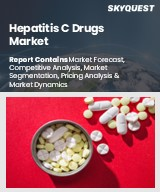
|
시장보고서
상품코드
1832217
항바이러스제 시장 : 적응증별, 약제 클래스별, 투여 경로별, 유통 채널별, 최종사용자별 - 세계 예측(2025-2032년)Antiviral Drugs Market by Indication, Drug Class, Route Of Administration, Distribution Channel, End User - Global Forecast 2025-2032 |
||||||
항바이러스제 시장은 2032년까지 연평균 복합 성장률(CAGR) 6.73%로 1,008억 3,000만 달러에 이를 것으로 예측됩니다.
| 주요 시장 통계 | |
|---|---|
| 예측연도(2024년) | 598억 4,000만 달러 |
| 기준연도(2025년) | 638억 1,000만 달러 |
| 예측연도(2032년) | 1,008억 3,000만 달러 |
| CAGR(%) | 6.73% |
과학적 진보, 임상적 압력, 전략적 리더를 위한 시스템 적용을 통합하여 현재 항바이러스 치료제 상황에 대한 간결한 오리엔테이션을 제공합니다.
항바이러스제를 둘러싼 환경은 치료 혁신, 치료 전달 모델의 변화, 규제 환경의 진화가 교차하며 연구, 개발, 상업적 접근 방식을 재구성하는 변곡점에 있습니다. 이 경영진 요약은 적응증별, 약효군별, 유통채널별 가장 중요한 동향을 정리하고, 이러한 동향을 임상팀, 상업적 리더, 공급망 경영진에게 전략적 중요성으로 해석하고 있습니다. 그 목적은 당장의 업무적 우선순위와 장기적인 연구개발 경로의 균형을 맞추어야 하는 리더를 위해 복잡하고 다양한 분야의 데이터를 실행 가능한 형태로 압축하여 제시하는 것입니다.
이해관계자 그룹 간의 연관성을 보장하기 위해 이 분석은 항바이러스 치료의 개발 및 제공 방법을 재정의하고 있는 임상적 미충족 수요, 기술적 타당성, 시스템 압력을 배경으로 하고 있습니다. 이 분석은 항바이러스 치료법 및 진단법 발전과 같은 과학적 궤적과 조달 방법, 지불자의 참여, 외래 치료의 실용화 등 실용적인 고려 사항을 통합합니다. 전체적으로 환자 접근성, 치료 가치, 공급 중단에 대한 탄력성에 영향을 미치는 결정에 중점을 두어 계획 및 투자 의사결정에 간결하면서도 미묘한 방향성을 제공합니다.
항바이러스제 개발 및 상업화 경로를 근본적으로 바꾸고 있는 과학적, 규제적, 공급적 혁신에 대한 심층 분석
항바이러스제 개발 및 전달 경쟁과 임상의 윤곽을 바꾸고 있는 여러 가지 변혁적 변화들. 생물학적 방법과 핵산 기술은 개념 증명 단계에서 효과적인 치료 전략으로 전환하고 있으며, 효과 지속 시간 연장, 순응도 개선, 표적 메커니즘에 기반한 개입을 목표로 하는 프로그램에 박차를 가하고 있습니다. 동시에, 진단약은 치료제와 융합하여 조기 발견과 검사 및 치료 패러다임을 가능하게 하고 있으며, 이는 임상시험 설계와 상업적 접근 전략에 영향을 미치고 있습니다.
규제 당국의 경로가 수요가 높은 분야의 개발 가속화를 위해 조정되고 있으며, 지불자는 실제 임상 결과와 의료 경제적 가치를 입증하는 것에 대한 상환을 연결하고 있습니다. 디지털 헬스 툴은 환자 모니터링 및 순응도 프로그램에 통합되어 분산형 케어 모델을 지원하고, 임상적으로 적절한 경우 입원 환경으로부터 활용을 전환하고 있습니다. 유연한 생물학적 제제 생산 능력과 모듈식 생산 기술 등 제조 기술 혁신은 리드 타임을 단축하고 지역화된 공급망을 가능하게 하고 있습니다. 이러한 변화로 인해 민첩성, 부문 간 파트너십, 신속한 증거 창출이 누가 과학적 가능성을 지속적인 임상적, 상업적 성공으로 연결시킬 수 있는지를 결정짓는 상황이 조성되고 있습니다.
2025년 미국 관세 개정이 당면한 조달 압력과 공급망 탄력성 및 제조 현지화의 전략적 유인을 창출하는 방법에 대한 종합적인 평가
2025년 시행되는 미국 관세 조정의 누적 효과는 항바이러스 치료제 관련 조직에 조달, 제조, 임상 업무 전반에 걸쳐 다면적인 압박을 가할 것입니다. 주요 화학 중간체 및 특정 완제의약품에 대한 수입 관세는 세계 공급망에 의존하는 기업들에게 상륙 비용을 증가시키고, 조달팀은 조달 전략을 재검토하고, 연속성을 유지하기 위해 니어쇼어링 및 대체 공급업체의 적격성을 검토하도록 촉구하고 있습니다. 이러한 공급업체 다변화를 위한 방향 전환은 대체 제조 파트너를 인증하고 규제 품질 표준을 준수하기 위해 상당한 리드 타임과 자본 투자가 필요한 경우가 많습니다.
클리닉과 병원 시스템은 조달 가격의 변동성 증가에 직면하여 구매 주기 및 재고 정책에 영향을 미칩니다. 한 의료기관은 재고 완충액을 확대하고, 또 다른 의료기관은 변동성을 완화하기 위해 장기 구매 계약을 협상하고 있습니다. 개발 기업에게 관세로 인한 비용 압박은 제조 확장의 규모화 장소와 방법에 대한 계산을 바꿀 수 있으며, 현지의 높은 운영 비용에도 불구하고 국경 간 관세의 영향을 덜 받는 지역의 생산 기지를 선호할 수 있습니다. 관세는 또한 제조 계약 조직의 역학에도 영향을 미쳐 국내 또는 지역의 적격 생산 능력에 대한 수요 증가로 인해 납기와 가격에 대한 경쟁 압력이 발생하기 때문에 관세는 제조 계약 조직의 역학에도 영향을 미칩니다.
영향을 상쇄하기 위한 정책적 대응과 민간 부문의 전략으로 표적 공급 계약, 수직적 통합 추진, 중요 원료의약품의 전략적 비축 등이 대두되고 있습니다. 이러한 조정은 임상시험 재료공급 속도, 지불자 및 조달업체와의 가격 협상 시 비용 기준, 더 복잡한 인풋이 필요하지 않은 치료 파이프라인의 우선순위 지정 등 다운스트림에 영향을 미칩니다. 전반적으로 관세 환경은 공급망의 탄력성과 이중화로의 전략적 전환을 가속화하는 한편, 공정 혁신과 제조 효율을 통한 비용 절감의 중요성을 높이고 있습니다.
효과적인 전략을 가진 기업: 적응증, 치료 클래스, 투여 경로, 유통 채널, 최종 사용자 역학에 걸친 상세한 세분화 인사이트를 통해 차별화 전략을 추진합니다.
적응증별로는 B형 간염, C형 간염, 단순포진, HIV, 인플루엔자, 호흡기 증후군 바이러스에서 임상적 니즈와 상업적 전략의 차별화 경로를 확인할 수 있었습니다. B형 간염 프로그램은 지속적인 바이러스 억제와 기능적 치료 전략에 점점 더 초점을 맞추고 있으며, 장기적인 안전성과 바이오마커 개발이 요구되고 있는 반면, C형 간염 프로그램은 간편한 요법과 광범위한 사례 발견을 지원하는 접근 모델에 초점을 맞추었습니다. 단순포진 관리는 여전히 고위험군에 대한 우발적 통제와 예방에 집중하고 있으며, HIV 연구는 확립된 만성 치료 모델과 함께 장기 지속형 제제와 치료 지향적 접근법의 균형을 맞추고 있습니다. 인플루엔자 및 호흡기세포융합바이러스 프로그램에서는 치료와 예방의 타이밍을 최적화하기 위해 계절에 따른 치료와 신속한 진단을 우선시하고 있습니다.
약제 유형별로 보면, 우선순위는 융합 억제제, 인테그라제 억제제, 비뉴클레오시드계 역전사효소 억제제, 뉴클레오시드 유사체, 프로테아제 억제제 순으로 나타났습니다. 인테그라제 억제제와 융합 억제제는 새로운 내성 프로파일과 내약성 우위로 인해 관심을 받고 있지만, 뉴클레오시드 유사체와 프로테아제 억제제는 신중한 라이프사이클 관리가 필요한 확립된 요법의 기반이 되고 있습니다. 비뉴클레오시드 역전사효소 억제제는 안전성 프로파일을 개선하고 지속성과 순응도를 높이기 위한 병용 전략에 대한 평가가 계속되고 있습니다.
흡입, 주사, 경구, 외용 등의 투여 경로는 환자의 순응도, 유통 물류, 임상 환경을 형성합니다. 경구제는 외래 환자 관리와 만성 질환 유지의 중심이 되고, 주사제와 지속형 제제는 복약 순응도를 높이고 병원 방문 빈도를 줄이며, 흡입제는 호흡기 바이러스에 대한 표적화된 폐 노출을 제공하고, 국소 제제는 점막 피부 감염에 대한 내약성을 향상시키는 국소 제제의 관련성을 유지합니다.
진료소, 병원 약국, 온라인 약국, 소매 약국 등 다양한 유통 채널의 역학관계는 접근성, 상환 경로, 진료 시점 결정에 영향을 미칩니다. 진료소나 병원 약국에서는 복잡한 처방이나 비경구제제를 취급하는 경우가 많지만, 온라인 약국이나 소매 약국에서는 경구제제나 국소제제에 대한 접근성과 편의성이 확대됩니다. 마지막으로 진료소, 재택의료, 병원, 장기요양시설 등 최종 사용자 세분화는 치료법 선택에 있어 의료 환경의 중요성을 강조하고 있습니다. 재택의료 및 외래진료소에서는 사용하기 쉬운 제형과 간소화된 모니터링 프로토콜에 대한 수요가 증가하고 있으며, 병원 및 장기요양시설에서는 복잡한 요법에 대한 견고한 공급 및 관리 워크플로우가 요구되고 있습니다.
미주, 유럽, 중동 및 아프리카, 아시아태평양의 규제, 임상 및 제조 요인이 어떻게 실행 선택을 형성하는지 강조하는 전략적 지역별 고찰
지역 역학은 항바이러스제의 연구개발 우선순위, 제조 배치, 상업화 접근방식을 형성하는 데 있어 중요한 역할을 합니다. 북미와 남미에서는 확립된 연구 인프라와 광범위한 임상시험 네트워크가 신속한 번역 활동을 지원하는 반면, 정책적 논쟁과 지불자 프레임워크가 가격 전략과 접근 모델에 영향을 미칩니다. 또한, 미주 대륙은 장기지속형 및 첨단 치료제 출시의 주요 시장으로 작용하고 있으며, 복잡한 가치 기반 계약과 시판 후 증거 수집에 대응할 수 있는 헬스케어 시스템을 갖추고 있습니다.
유럽, 중동 및 아프리카는 규제 조화에 대한 노력과 다양한 상환 상황이 공존하는 이질적인 환경입니다. 유럽의 규제 프레임워크는 확고한 비교 유효성 및 의료 경제성 근거를 중시하며, 제조업체가 개발 초기에 실제 임상 데이터 수집 및 지불자 참여에 투자할 수 있는 동기를 부여합니다. 중동 및 아프리카은 의약품 접근성에 대한 분명한 과제와 소외 계층을 위한 제조 역량 구축 및 유통 네트워크에 초점을 맞춘 민관 파트너십의 기회를 제공합니다.
아시아태평양은 빠르게 확대되는 R&D 투자, 대규모 미충족 수요가 있는 환자 집단, 신흥 제조 역량을 갖춘 다양한 지역입니다. 아시아태평양의 일부 경제 국가들은 저분자 의약품 및 생물학적 제제 제조에 많은 투자를 하고 있으며, 유리한 정책적 인센티브를 통해 임상 개발 처리량을 가속화하고 있습니다. 이 지역의 상업적 전략은 이질적인 지불자 제도, 환자의 지불 가능 금액의 변화, 환자와의 관계 및 유통에서 디지털 채널의 역할 증가를 조정할 필요가 있습니다. 어느 지역에서든 성공적인 프로그램은 증거 창출, 공급망 설계, 상업적 모델을 지역의 규제적 기대와 의료 서비스 제공 현실에 맞게 조정하는 것입니다.
항바이러스제 개발 및 상업화에서 경쟁 우위를 가져다주는 혁신, 제조 전략, 파트너십 모델에 대한 실질적인 기업 차원의 관점을 제공합니다.
항바이러스 치료제 분야의 기업 전략은 차별화된 치료제 개발, 탄력적인 제조 역량 확보, 생태계 전반에 걸친 협력적 파트너십 구축 등 몇 가지 우선순위로 집약되고 있습니다. 주요 개발사들은 기술 리스크를 관리하면서 새로운 메커니즘에 대한 접근을 가속화할 수 있는 타겟 라이선스 계약 및 공동 개발 계약과 자체 혁신의 균형을 맞추고 있습니다. 바이러스 표적에 대한 모듈식 적응이 가능한 플랫폼 기술에 대한 투자는 신약개발에서 임상 후보물질로의 빠른 전환을 가능하게 하며, 기업들은 약물 순응도를 개선하고 집중적인 모니터링의 필요성을 줄이기 위한 명확한 경로를 가진 자산을 우선시하는 경향이 있습니다.
비즈니스 측면에서 기업들은 공급망 통합을 강화하고, 선택적 수직 이전과 전략적 제조 제휴를 통해 생산 능력을 확장하고, 국경 간 비용 충격에 대한 노출을 줄이고 있습니다. 상업적 측면에서는 장기적인 성과와 상환 구조를 일치시키는 가치 기반 계약 및 지불자와의 제휴를 시도하는 한편, 전문 상업화 팀이 병원 포뮬러 및 전문 약국과 같은 차별화 된 채널에 집중하고 있습니다. 반면, 대형 다국적 제약사는 규모, 규제에 대한 전문성, 세계 유통망에 대한 접근성을 제공합니다. 모든 유형의 기업에서 임상적 차별성을 환자와 시스템의 가치로 입증하고, 그 가치를 복잡한 치료 경로를 통해 실용화할 수 있느냐가 성공의 열쇠가 되고 있습니다.
항바이러스제의 지속적인 성공을 위해 R&D 우선순위 설정, 제조의 견고성, 지불자의 참여, 상업적 실행에 대한 구체적이고 우선순위가 높은 권고 사항
업계 리더는 R&D 선택과 상업적 실행 및 공급망 강인성을 일치시키는 일련의 실행 가능한 조치를 우선순위에 두어야 합니다. 첫째, 순응도를 분명히 개선하고, 시스템 부담을 줄여주는 지속적이고 표적화된 전달 방식에 대한 투자를 가속화하고, 임상 개발 계획과 상환을 뒷받침하는 실제 임상 증거 수집을 위한 탄탄한 계획을 결합합니다. 둘째, 지역 파트너 및 유연한 제조 위탁업체를 확보하여 제조 발자국을 다양화하고, 관세로 인한 혼란이나 투입물 부족에 대비한 시나리오 계획을 수립하여 임상시험 및 상업적 공급에 대한 리스크를 최소화합니다.
셋째, 진단과 원격 의료 경로를 통합하는 출시 전략을 수립하여 치료 적격 환자를 신속하게 식별하고 치료 시작에 대한 장벽을 줄일 수 있습니다. 넷째, 지불자를 조기에 참여시켜 증거 요건을 정의하고, 위험과 보상을 공유하는 결과 기반 상환 구조를 모색합니다. 다섯째, 공동 개발, 라이선싱 또는 역량 격차를 해소할 수 있는 타겟형 인수 등을 통해 플랫폼 기술과 상업화 전문성을 결합한 전략적 제휴를 육성합니다. 여섯째, 복약 순응도를 높이고, 결과 데이터를 수집하며, 총 의료비를 절감할 수 있는 디지털 환자 지원 프로그램에 투자합니다. 마지막으로, 조달 및 제조 의사결정에 지속가능성을 포함시킴으로써 지정학적 및 관세 압력에 노출될 기회를 줄이고, 탄력적이고 책임감 있는 사업 운영에 대한 이해관계자들의 기대에 부응할 수 있습니다.
전문가 인터뷰, 규제 및 과학적 검토, 실행 가능한 통찰력을 검증하기 위한 시나리오 분석을 결합한 다면조사 기법을 투명하게 설명합니다.
본 Executive Summary의 기초가 되는 조사는 전문가 1차 조사, 2차 문헌, 규제 당국 신고, 기술 데이터 소스를 삼위일체적으로 접근하여 종합적이고 검증 가능한 통찰력을 얻었습니다. 1차 입력에는 임상시험 책임자, 공급망 관리자, 규제 당국 전문가, 상업적 업계 리더과의 구조화된 인터뷰를 통해 업무상의 과제, 임상적 우선순위, 지불 측의 기대에 대한 현장 수준의 관점을 제공했습니다. 2차 검토에서는 동료평가 문헌, 임상시험 등록, 특허 현황, 공공 규제 결정, 과학적 동향 및 개발 파이프라인을 매핑하는 등 다양한 정보를 수집했습니다.
분석 방법으로는 반복적으로 나타나는 전략적 주제를 파악하기 위한 질적 주제별 통합, 지역별 규제의 영향을 파악하기 위한 비교 정책 분석, 공급망과 관세에 미치는 영향을 평가하기 위한 시나리오 플래닝 등이 포함됐습니다. 인터뷰 결과를 문서 검토를 통해 상호 검증하고, 중간 주제를 독립적인 전문가 패널에게 제시하여 피드백을 받음으로써 품질 보증을 유지했습니다. 조사 방법론에서는 인터뷰 대상자의 샘플링 편향 가능성, 빠르게 진화하는 임상 연구의 특성 등 호라이즌 스캐닝과 전문가 인터뷰에 내재된 한계를 인식하고, 다양한 이해관계자의 참여와 반복적인 검증 주기를 통해 이러한 한계를 완화했습니다. 이러한 한계는 다양한 이해관계자의 참여와 반복적인 검증 주기를 통해 완화되었습니다. 그 결과, 단기적인 비즈니스 요구와 장기적인 전략 목표의 일관성을 추구하는 의사결정자들에게 견고성과 실용적인 타당성을 우선시하는 통찰력을 얻을 수 있었습니다.
항바이러스 치료제의 과학적 가능성을 지속적인 임상적, 상업적 성공으로 연결하기 위한 중요한 전략적 우선순위의 최종 통합
요약하면, 항바이러스 치료제는 기술적 모멘텀, 공급망의 복잡성, 시장 진입 요건의 진화에 의해 정의되는 시기를 맞이하고 있습니다. 과학적 발전은 더 오래 지속되는 약물과 표적화된 치료법을 통해 환자 결과를 개선할 수 있는 명확한 경로를 제공하지만, 그 성공 여부는 적응형 제조 전략, 통합된 진단 방법, 정교한 지불자의 참여에 달려있습니다. 각 지역 규제 당국의 기대와 관세에 따라 달라지는 공급 역학의 상호 작용은 지역 기반의 실행과 탄탄한 위기 관리 계획의 중요성을 강조하고 있습니다.
임상 개발을 실용적인 가치 증명과 일치시키고, 제조 및 조달 접근 방식을 다양화하며, 순응도와 증거 수집을 위한 디지털 도구에 투자하는 개발 리더는 과학적 잠재력을 접근 가능한 치료법으로 전환할 수 있는 가장 좋은 위치에 서게 될 것입니다. 이 요약에 포함된 권고사항은 지속적인 경쟁 우위를 구축하기 위한 장기적인 투자를 지원하는 한편, 당면한 비즈니스 의사결정의 지침이 될 수 있도록 하기 위한 것입니다. 전술적 대응과 전략적 선견지명을 가지고 행동하는 조직은 진화하는 안티바이러스 상황에서 단기적인 혼란을 완화하고 지속 가능한 성장 기회를 창출할 수 있습니다.
목차
제1장 서론
제2장 분석 방법
제3장 주요 요약
제4장 시장 개요
제5장 시장 인사이트
제6장 미국 관세의 누적 영향 2025
제7장 AI의 누적 영향 2025
제8장 항바이러스제 시장 : 적응증별
- B형 간염
- C형 간염
- 단순 헤르페스
- HIV
- 인플루엔자
- RS 바이러스
제9장 항바이러스제 시장 : 약제 클래스별
- 융합 억제제
- 인테그라제 억제제
- 비뉴클레오티드계 역전사진 효소 억제제
- 뉴클레오티드 유사체
- 프로테아제 억제제
제10장 항바이러스제 시장 : 투여 경로별
- 흡입
- 주사
- 경구
- 외용
제11장 항바이러스제 시장 : 유통 채널별
- 클리닉
- 병원 약국
- 온라인 약국
- 소매 약국
제12장 항바이러스제 시장 : 최종사용자별
- 클리닉
- 재택치료
- 병원
- 장기요양시설
제13장 항바이러스제 시장 : 지역별
- 아메리카
- 북미
- 라틴아메리카
- 유럽, 중동 및 아프리카
- 유럽
- 중동
- 아프리카
- 아시아태평양
제14장 항바이러스제 시장 : 그룹별
- ASEAN
- GCC
- EU
- BRICS
- G7
- NATO
제15장 항바이러스제 시장 : 국가별
- 미국
- 캐나다
- 멕시코
- 브라질
- 영국
- 독일
- 프랑스
- 러시아
- 이탈리아
- 스페인
- 중국
- 인도
- 일본
- 호주
- 한국
제16장 경쟁 구도
- 시장 점유율 분석(2024년)
- FPNV 포지셔닝 매트릭스(2024년)
- 경쟁 분석
- Gilead Sciences, Inc.
- AbbVie Inc.
- F. Hoffmann-La Roche Ltd
- Merck & Co., Inc.
- GlaxoSmithKline plc
- Pfizer Inc.
- Johnson & Johnson
- Bristol-Myers Squibb Company
- ViiV Healthcare Limited
- AstraZeneca plc
The Antiviral Drugs Market is projected to grow by USD 100.83 billion at a CAGR of 6.73% by 2032.
| KEY MARKET STATISTICS | |
|---|---|
| Base Year [2024] | USD 59.84 billion |
| Estimated Year [2025] | USD 63.81 billion |
| Forecast Year [2032] | USD 100.83 billion |
| CAGR (%) | 6.73% |
Concise orientation to the current antiviral therapeutics landscape that synthesizes scientific advances, clinical pressures, and system implications for strategic leaders
The antiviral drugs landscape is at an inflection point where therapeutic innovation, shifting care delivery models, and evolving regulatory expectations intersect to reshape research, development, and commercial approaches. This executive summary synthesizes the most consequential developments across indications, drug classes, and distribution channels, and it translates those developments into strategic implications for clinical teams, commercial leaders, and supply chain executives. The goal is to present an actionable condensation of complex, cross-disciplinary data for leaders who must balance near-term operational priorities with longer-term R&D pathways.
To ensure relevance across stakeholder groups, the analysis foregrounds clinical unmet needs, technology enablers, and system pressures that are redefining how antiviral therapies are developed and delivered. The narrative integrates scientific trajectories-such as advances in antiviral modalities and diagnostics-with practical considerations including procurement practices, payer engagement, and the operationalization of outpatient care. Throughout, emphasis is placed on decisions that influence patient access, therapeutic value, and resilience against supply disruptions, providing a concise yet nuanced orientation for planning and investment decisions.
Detailed analysis of the converging scientific, regulatory, and delivery innovations that are fundamentally reshaping development and commercialization pathways for antivirals
A number of transformative shifts are altering the competitive and clinical contours of antiviral therapy development and delivery. Biologic modalities and nucleic acid technologies have moved from proof-of-concept stages into validated therapeutic strategies, fueling programs that aim to deliver longer duration of effect, improved adherence, and targeted mechanism-based interventions. Concurrently, diagnostics are converging with therapeutics to enable earlier detection and test-and-treat paradigms, which in turn influence clinical trial design and commercial access strategies.
Regulatory pathways have adjusted to accommodate accelerated development in high-need areas, and payers are increasingly tying reimbursement to demonstrable real-world outcomes and health economic value. Digital health tools are being integrated into patient monitoring and adherence programs, supporting decentralized care models and shifting utilization away from inpatient settings when clinically appropriate. Manufacturing innovation, including flexible biologics capacity and modular production techniques, is reducing lead times and enabling regionalized supply chains. These shifts collectively create a landscape in which agility, cross-sector partnerships, and rapid evidence generation determine who can translate scientific promise into durable clinical and commercial success.
Comprehensive assessment of how the 2025 United States tariff changes create immediate procurement pressures and strategic incentives for supply chain resilience and manufacturing localization
The cumulative effect of the United States tariff adjustments enacted in 2025 introduces multifaceted pressures across procurement, manufacturing, and clinical operations for organizations engaged in antiviral therapeutics. Import duties on key chemical intermediates and selected finished pharmaceuticals have increased landed costs for firms that rely on global supply networks, prompting procurement teams to reassess sourcing strategies and to explore nearshoring or alternate supplier qualification to maintain continuity. This reorientation toward supplier diversification often requires significant lead time and capital investment to qualify alternate manufacturing partners and to ensure compliance with regulatory quality standards.
Clinics and hospital systems face increased variability in procurement pricing, which in turn affects purchasing cycles and inventory policies; some institutions are extending inventory buffers while others are negotiating longer term purchasing agreements to mitigate volatility. For developers, tariff-driven cost pressures can change the calculus for where and how manufacturing scale-up is executed, potentially favoring regional production hubs that reduce exposure to cross-border duties despite higher local operating costs. The tariffs also influence the dynamics of contract manufacturing organizations, as increased demand for domestic or qualified regional capacity creates competitive pressure on timelines and pricing.
Policy responses and private sector strategies are emerging to offset impacts, including targeted supply agreements, increased vertical integration, and strategic stockpiling for critical active pharmaceutical ingredients. These adjustments have downstream effects on the speed of clinical trial material provisioning, the cost base for pricing negotiations with payers and procurers, and the prioritization of therapeutic pipelines that require fewer complex inputs. In aggregate, the tariff environment accelerates a strategic shift toward resilience and redundancy in supply chains while elevating the importance of cost containment through process innovation and manufacturing efficiency.
In-depth segmentation insights spanning indications, therapeutic classes, administration routes, distribution channels, and end-user dynamics driving differentiated strategies
Segmentation by indication reveals differentiated pathways of clinical need and commercial strategy across Hepatitis B, Hepatitis C, Herpes Simplex, HIV, Influenza, and Respiratory Syncytial Virus. Hepatitis B programs are increasingly focused on durable viral suppression and functional cure strategies, demanding long-term safety and biomarker development, whereas Hepatitis C efforts emphasize simplified regimens and access models that support broad case finding. Herpes Simplex management remains concentrated on episodic control and prophylaxis for high-risk populations, while HIV research balances long-acting formulations and cure-directed approaches alongside established chronic care models. Influenza and Respiratory Syncytial Virus programs prioritize seasonally responsive therapies and rapid diagnostics to optimize timing of treatment and prophylaxis.
When viewed by drug class, priorities vary between Fusion Inhibitors, Integrase Inhibitors, Non-Nucleoside Reverse Transcriptase Inhibitors, Nucleoside Analogues, and Protease Inhibitors. Integrase and fusion inhibitors are attracting interest for novel resistance profiles and tolerability advantages, while nucleoside analogues and protease inhibitors remain foundational for established regimens that require careful lifecycle management. Non-Nucleoside Reverse Transcriptase Inhibitors continue to be evaluated for improved safety profiles and combination strategies that enhance durability and adherence.
Routes of administration, spanning inhalation, injectable, oral, and topical, shape patient adherence, distribution logistics, and clinical setting. Oral therapies remain central for outpatient management and chronic disease maintenance, injectables and long-acting formulations support adherence and reduce clinic visit frequency, inhalation therapeutics offer targeted pulmonary exposure for respiratory viruses, and topical formulations maintain relevance for mucocutaneous infections where localized delivery improves tolerability.
Distribution channel dynamics across clinics, hospital pharmacies, online pharmacies, and retail pharmacies influence access, reimbursement pathways, and point-of-care decisioning. Clinics and hospital pharmacies often handle complex regimens and parenteral products supported by institutional procurement processes, while online and retail pharmacies expand reach and convenience for oral and topical therapies. Finally, end user segmentation that includes clinics, home care, hospitals, and long term care facilities highlights the importance of care setting in therapeutic choice, with home care and outpatient clinics driving demand for user-friendly formulations and simplified monitoring protocols, and hospitals and long term care facilities requiring robust supply and administration workflows for complex regimens.
Strategic regional considerations highlighting how distinct regulatory, clinical, and manufacturing factors in the Americas, Europe Middle East & Africa, and Asia-Pacific shape execution choices
Regional dynamics are central to shaping R&D priorities, manufacturing placement, and commercialization approaches across the antiviral landscape. In the Americas, established research infrastructure and widespread clinical trial networks support rapid translational efforts, while policy debates and payer frameworks influence pricing strategies and access models. The Americas also function as a key market for long-acting and advanced modality launches, with healthcare systems that can absorb complex value-based contracting and post-launch evidence collection.
Europe, the Middle East & Africa present a heterogeneous environment where regulatory harmonization efforts coexist with varied reimbursement landscapes. European regulatory frameworks favor robust comparative effectiveness and health economic evidence, motivating manufacturers to invest in real-world data generation and payer engagement early in development. The Middle East & Africa region presents distinct access challenges and opportunities for public-private partnerships focused on manufacturing capacity building and distribution networks that reach underserved populations.
Asia-Pacific is a diverse region that combines rapidly expanding R&D investment, large patient populations with significant unmet needs, and emerging manufacturing prowess. Several economies within Asia-Pacific are investing heavily in both small molecule and biologics manufacturing, and favorable policy incentives are accelerating clinical development throughput. Commercial strategies in the region must reconcile heterogenous payer systems, variable patient affordability, and the increasing role of digital channels for patient engagement and distribution. Across all regions, successful programs are those that tailor evidence generation, supply chain design, and commercial models to local regulatory expectations and care delivery realities.
Practical company-level perspectives on innovation, manufacturing strategy, and partnership models that are driving competitive advantage in antiviral development and commercialization
Company strategies in antiviral therapeutics are converging on a few high-impact priorities: advancing differentiated modalities, securing resilient manufacturing capacity, and forging collaborative partnerships across the ecosystem. Leading developers are balancing in-house innovation with targeted licensing and co-development agreements that accelerate access to novel mechanisms while managing technical risk. Investment in platform technologies that enable modular adaptation across viral targets is enabling faster transition from discovery to clinical candidate, and companies are increasingly prioritizing assets with clear pathways to improved adherence or reduced need for intensive monitoring.
Operationally, firms are bolstering supply chain integration and expanding capacity through selective vertical moves or strategic manufacturing partnerships to reduce exposure to cross-border cost shocks. Commercially, organizations are experimenting with value-based contracting and payer partnerships that align long-term outcomes with reimbursement structures, while specialist commercialization teams focus on differentiated channels such as hospital formularies and specialty pharmacies. Smaller biotech firms are leveraging nimble development processes and focused proof-of-concept studies to attract partnerships, while larger multinational pharmaceutical companies provide scale, regulatory expertise, and access to global distribution networks. Across company types, success increasingly depends on the ability to translate clinical differentiation into demonstrable patient and system value and to operationalize that value across complex care pathways.
Concrete and prioritized recommendations for R&D prioritization, manufacturing resilience, payer engagement, and commercial execution to drive durable success in antivirals
Industry leaders should prioritize a suite of actionable measures that align R&D choices with commercial execution and supply chain resilience. First, accelerate investment in long-acting and targeted delivery modalities that demonstrably improve adherence and reduce system burden, pairing clinical development plans with robust plans for real-world evidence collection to support reimbursement. Second, diversify manufacturing footprints by qualifying regional partners and flexible contract manufacturers, and incorporate scenario planning for tariff-driven disruptions and input scarcity to minimize risks to clinical trials and commercial supply.
Third, design launch strategies that integrate diagnostics and telehealth pathways, enabling rapid identification of treatment-eligible patients and reducing barriers to initiation. Fourth, engage payers early to define evidence requirements and to explore outcome-based reimbursement structures that share risk and reward. Fifth, cultivate strategic alliances that pair platform technologies with commercialization expertise, whether through co-development, licensing, or targeted acquisitions that fill capability gaps. Sixth, invest in digital and patient support programs that improve adherence, collect outcome data, and reduce the total cost of care. Finally, embed sustainability into procurement and manufacturing decisions to reduce exposure to geopolitical and tariff pressures while meeting growing stakeholder expectations for resilient and responsible operations.
Transparent description of the multi-method research approach combining expert interviews, regulatory and scientific review, and scenario analysis to validate actionable insights
The research underpinning this executive summary draws on a multi-method approach that triangulates primary expert interviews, secondary literature, regulatory filings, and technical data sources to ensure comprehensive and validated insights. Primary inputs included structured interviews with clinical investigators, supply chain managers, regulatory experts, and commercial leaders, providing ground-level perspectives on operational challenges, clinical priorities, and payer expectations. Secondary review encompassed peer-reviewed literature, clinical trial registries, patent landscapes, and public regulatory decisions to map scientific trends and development pipelines.
Analytical methods included qualitative thematic synthesis to identify recurrent strategic themes, comparative policy analysis to discern regional regulatory implications, and scenario planning to evaluate supply chain and tariff impacts. Quality assurance was maintained through cross-validation of interview findings with document review and by presenting interim themes to an independent panel of subject matter experts for feedback. The methodology acknowledges limitations inherent to horizon scanning and expert elicitation, including potential sampling bias in interview subjects and the rapidly evolving nature of clinical research; these limitations were mitigated through diverse stakeholder engagement and repeated validation cycles. The resulting insights prioritize robustness and practical relevance for decision makers seeking to align near-term operational imperatives with longer-term strategic objectives.
Final synthesis of the critical strategic priorities for converting scientific promise into durable clinical and commercial success in antiviral therapeutics
In summation, antiviral therapeutics are entering a period defined by technological momentum, heightened supply chain complexity, and evolving market access requirements. Scientific advances provide clear pathways to improved patient outcomes through longer-acting agents and targeted modalities, yet successful translation depends on adaptive manufacturing strategies, integrated diagnostics, and sophisticated payer engagement. The interplay of regional regulatory expectations and tariff-driven supply dynamics underscores the importance of localized execution and robust contingency planning.
Leaders who align clinical development with pragmatic proofs of value, diversify manufacturing and procurement approaches, and invest in digital tools for adherence and evidence capture will be best positioned to convert scientific potential into accessible therapies. The recommendations contained in this summary are intended to guide immediate operational decisions while supporting longer-term investments that build durable competitive advantage. Organizations that act with both tactical responsiveness and strategic foresight can mitigate near-term disruptions and unlock sustainable growth opportunities in the evolving antiviral landscape.
Table of Contents
1. Preface
- 1.1. Objectives of the Study
- 1.2. Market Segmentation & Coverage
- 1.3. Years Considered for the Study
- 1.4. Currency & Pricing
- 1.5. Language
- 1.6. Stakeholders
2. Research Methodology
3. Executive Summary
4. Market Overview
5. Market Insights
- 5.1. Rapid adoption of long-acting injectable antiviral therapies for HIV prevention and treatment
- 5.2. Expansion of direct-acting antiviral regimens for hepatitis C in resource-limited settings
- 5.3. Development of broad-spectrum antiviral agents targeting conserved viral polymerases and proteases
- 5.4. Growth of monoclonal antibody prophylactics for respiratory syncytial virus in high-risk pediatric populations
- 5.5. Integration of artificial intelligence and machine learning in antiviral drug discovery and repurposing efforts
- 5.6. Emergence of combination antiviral therapies enhancing potency against drug-resistant influenza strains
- 5.7. Increased investment in pan-coronavirus therapeutic platforms for pandemic preparedness
6. Cumulative Impact of United States Tariffs 2025
7. Cumulative Impact of Artificial Intelligence 2025
8. Antiviral Drugs Market, by Indication
- 8.1. Hepatitis B
- 8.2. Hepatitis C
- 8.3. Herpes Simplex
- 8.4. Hiv
- 8.5. Influenza
- 8.6. Respiratory Syncytial Virus
9. Antiviral Drugs Market, by Drug Class
- 9.1. Fusion Inhibitors
- 9.2. Integrase Inhibitors
- 9.3. Non Nucleoside Reverse Transcriptase Inhibitors
- 9.4. Nucleoside Analogues
- 9.5. Protease Inhibitors
10. Antiviral Drugs Market, by Route Of Administration
- 10.1. Inhalation
- 10.2. Injectable
- 10.3. Oral
- 10.4. Topical
11. Antiviral Drugs Market, by Distribution Channel
- 11.1. Clinics
- 11.2. Hospital Pharmacies
- 11.3. Online Pharmacies
- 11.4. Retail Pharmacies
12. Antiviral Drugs Market, by End User
- 12.1. Clinics
- 12.2. Home Care
- 12.3. Hospitals
- 12.4. Long Term Care Facilities
13. Antiviral Drugs Market, by Region
- 13.1. Americas
- 13.1.1. North America
- 13.1.2. Latin America
- 13.2. Europe, Middle East & Africa
- 13.2.1. Europe
- 13.2.2. Middle East
- 13.2.3. Africa
- 13.3. Asia-Pacific
14. Antiviral Drugs Market, by Group
- 14.1. ASEAN
- 14.2. GCC
- 14.3. European Union
- 14.4. BRICS
- 14.5. G7
- 14.6. NATO
15. Antiviral Drugs Market, by Country
- 15.1. United States
- 15.2. Canada
- 15.3. Mexico
- 15.4. Brazil
- 15.5. United Kingdom
- 15.6. Germany
- 15.7. France
- 15.8. Russia
- 15.9. Italy
- 15.10. Spain
- 15.11. China
- 15.12. India
- 15.13. Japan
- 15.14. Australia
- 15.15. South Korea
16. Competitive Landscape
- 16.1. Market Share Analysis, 2024
- 16.2. FPNV Positioning Matrix, 2024
- 16.3. Competitive Analysis
- 16.3.1. Gilead Sciences, Inc.
- 16.3.2. AbbVie Inc.
- 16.3.3. F. Hoffmann-La Roche Ltd
- 16.3.4. Merck & Co., Inc.
- 16.3.5. GlaxoSmithKline plc
- 16.3.6. Pfizer Inc.
- 16.3.7. Johnson & Johnson
- 16.3.8. Bristol-Myers Squibb Company
- 16.3.9. ViiV Healthcare Limited
- 16.3.10. AstraZeneca plc



















